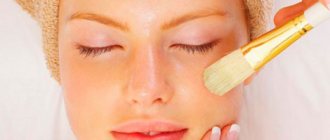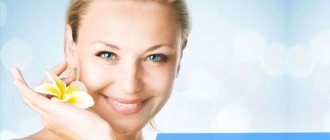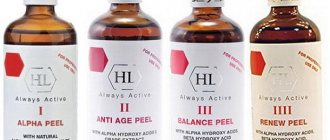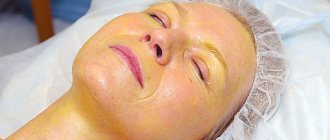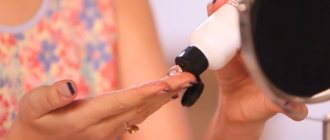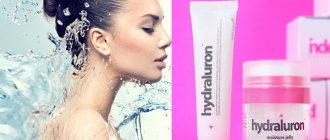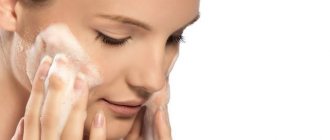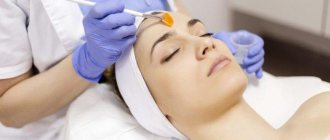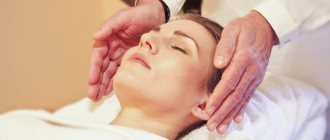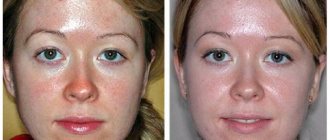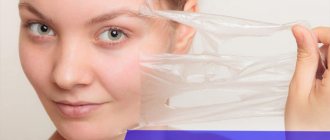Kosmoteros yellow peeling, a chemical type of exfoliation, allows for superficial exfoliation as a result of the action of retinoic acid.
The main active ingredient of this composition is a derivative of vitamin A; it has more pronounced exfoliating properties than the vitamin itself. Retinoic acid causes damage to the surface layer of the epithelium, which, after a certain time after the procedure, begins to peel off and move away from the dermis. After the peeling is eliminated, you can see the result - young, elastic skin, glowing with health.
Why "yellow"?
The official name of this facial peeling is retinoic , but people call it “yellow” because a yellow mask remains on the face during the procedure.
It is also called a “weekend peel” due to the rapid healing of the skin. It takes two days. Therefore, many women sign up for the procedure on Friday, and on Monday appear at work refreshed or as if they had flown to the sea on the weekend.
How much does yellow peeling cost and can you do it yourself?
The price of the procedure depends on what peeling composition is used, who its manufacturer is, and what preparatory steps the cosmetologist recommended.
The average cost of one session is 4500–8000 rubles. More expensive drugs are available in a wide variety. But in general, the price depends on how famous the brand is.
The most popular today are the compositions of cosmetic lines from famous large manufacturers, for example, GIGI (Israel), CosMedix (USA), SesDerma (Spain). You can buy yellow peeling procedures for the face with a drug from a leading company by paying 10,000 rubles or more.
Cleaning with retinoic acid should only be carried out in a specialized salon. Since its effect can be compared to a medium peel, you cannot carry out the procedure yourself, despite all precautions. Even the slightest mistake can lead to irreparable skin pigmentation.
Pros of yellow peeling
Fast recovery
We have already named the main one - a short rehabilitation period. If after harsher formulations skin restoration lasts at least a week, then after yellow peeling it takes only 2 days.
Held all year round
Due to the short recovery period of the skin, this type of peeling can be performed all year round, without interruption during the summer holidays. But still, summer is summer - discord. During periods of solar activity, it is better not to perform facial peels at all. Pigmentation has never graced anyone.
Retinol is vitamin A, which in any case increases photosensitivity, sensitivity to sunlight. Procedures carried out in the summer require powerful photoprotection, but there are basic recommendations to avoid this
Soft effect
Yellow peeling is considered the most gentle and can therefore be performed even on young skin, thin and sensitive skin.
Effective but superficial
According to the methods of implementation and the patient’s sensations, yellow peeling is considered superficial, but in terms of effectiveness it is equal to the average. It has a powerful effect on the skin of the face, while being quite soft.
Main indications and contraindications for yellow peeling
Since any acids, penetrating deep into the skin, enter the bloodstream, peeling with tretinoin is prohibited for use during pregnancy and breastfeeding. It is also undesirable to do it when planning conception: the exfoliation composition is harmful to the fetus, so it is recommended to carry out the procedure no later than a year before the expected pregnancy.
Retinoic peeling has other contraindications:
- inflammatory processes, chronic skin diseases, for example, herpes, eczema, rosacea;
- injuries, including scratches, wounds, burns, and warts;
- chronic liver diseases;
- hypersensitivity to the components of the composition, allergy, especially to vitamin C.
It is also unacceptable to cleanse while taking certain medications, including retinoids. In addition, when treating with certain drugs, you need to wait a while before the procedure:
- after antibiotics – 2 weeks;
- after Roaccutane – six months.
There are no age restrictions for the procedure. However, cosmetologists believe that it is advisable to carry it out after 30–35 years, and before that - only if there are scars or noticeable facial wrinkles on the skin, as well as with post-acne or inactive forms of acne.
Indications for retinoic cleansing include:
- uneven, dull complexion;
- pigmentation;
- lumpy skin;
- consequences of acne and acne;
- small wrinkles.
Cons of yellow peeling
The use of yellow peeling has its own characteristics. Depending on the protocol of use, it can be one-day or two-day.
In the first case, it is applied only in the afternoon and then it is not washed off; the person leaves the cosmetologist with a cream retinoic mask on his face. This can cause certain inconveniences (embarrassment in front of strangers, not being able to travel by public transport, driving a car is also inconvenient, etc.).
The second, two-day, is carried out in two stages, each lasting several hours, so it requires a lot of free time to carry out the procedure.
Procedure protocol
Yellow peeling Kosmoteros includes several stages in the protocol:
The preparatory stage is aimed at softening and removing dead epithelial cells so that exfoliation is more effective. Sensitive and dry skin does not require preparation. The preparation stage may include the following procedures:
- the use of creams or peelings based on fruit acids;
- using creams to soften the upper epidermis.
Important: do not sunbathe or use laser exfoliation before yellow peeling!
Carrying out the retinoic peeling procedure:
- applying glycolic acid to the face;
- using retinoic acid to exfoliate the face;
- maintaining a certain time;
- rinsing the product from the skin.
The cosmetologist selects the concentration of retinoic acid, as well as the duration of exposure, on an individual basis. Depending on the depth of exposure of the composition, superficial or medium exfoliation can be carried out. On the 2-3rd day the skin begins to peel off and come off.
Important! The crusts that form after exfoliation cannot be removed with your hands or exfoliated with scrubs. This can lead to the formation of scars and scars.
The cosmetologist will tell you how to properly do Kosmoteros yellow peeling and determine the course of procedures. There is a “two-day cleanse”, during which the composition is applied and washed off over 2 days. The effect of the procedure lasts from six months to a year. After this period, exfoliation with retinoids can be repeated.
Types of yellow peeling
As we have already mentioned, yellow peeling can be two-day or one-day. Both types are approved and recommended by the drug manufacturers.
One-day facial peeling
It is more popular because the recovery period is milder and there is less swelling.
It consists of two stages: the first procedure is carried out in the clinic (lasts from 30 minutes), the second the patient can carry out at home independently (apply peeling in the evening and leave until the morning).
The number of applications is individual for each patient (from 1 to 10) and depends on the condition of the skin.
Two-day facial peeling
With the classic peeling scheme, application takes several hours. Peeling is applied, washed off, reapplied, washed off again - and so on several times. This can last up to 4 hours.
All this happens under the supervision of a doctor, who looks at which areas need to be treated less and more intensively. The last application is left on the face, the patient goes home and there, after 2 hours, the peeling is washed off.
Day 2 – repeated peeling procedure, it differs from the first day and largely depends on what the reaction was on the first day.
The number of applications, again, is individual. Many doctors recommend performing several procedures at intervals of 10 to 14 days.
Features of yellow peeling and indications for the procedure
Peeling is used to remove the old layer of cells. This procedure helps to initiate restoration and rejuvenation of the skin, renewing it. Chemical peeling destroys the upper stratum corneum. The principle of action of retinoic, or yellow, peeling is different; it is based on the penetration of retinol, the main active ingredient, into the deep layers of the skin and stimulation of the active division of cells that are located there. As a result, the process is more gentle and there is no redness, as with conventional peeling. Cell renewal occurs. The skin is noticeably tightened and improved in appearance.
Retinoids that are involved in peeling are derivatives of vitamin A. In the human body, differentiation, cell division and their interaction depend on them. The active form of retinol is retinoic acid (or tretinoin), and can be found in plant and animal products. This acid is included in peeling compositions because it triggers cell renewal and improves metabolism. Tretinoin also activates fibroblasts, causing them to produce collagen and elastin, proteins that keep skin firm.
Retinoic acid has antioxidant properties and suppresses the harmful effects of free radicals on the body. Thanks to its anti-inflammatory properties, it is used in the treatment of skin diseases, including acne, psoriasis and dermatitis, and also reduces the healing time of damage and does not allow the development of hyperpigmentation, which appears after inflammation. In addition, retinoic acid is effective in removing freckles and age spots, as it has exfoliating properties and can inhibit tyrosinase, an enzyme that accelerates the synthesis of melanin and other pigments.
Benefits of tretinoin peels:
- practically does not injure the skin, so the procedure can be carried out even with high sensitivity;
- exfoliation can be done at any time of the year, even in spring and summer, using a cream with protection from ultraviolet rays;
- the recovery period is only a day or two;
- since retinoic acid is almost identical in composition to vitamin A, complications from peeling occur extremely rarely;
- Skin rejuvenation is very noticeable, the result lasts up to 4 months.
The effect of yellow peeling is comparable to the effect of medium peelings. But unlike them, during exfoliation with tretinoin, proteins do not coagulate and living epidermal cells are not destroyed. Compounds of this acid are able to establish connections with the receptors of the nuclei of many cells - basal cells, melanocytes, fibroblasts, as a result of which the procedure becomes effective and non-traumatic. Just one session, consisting of two stages, is equal in effectiveness to an entire course of peeling with glycolic acid.
Post-peeling care
After the yellow peeling procedure, it is advisable to cleanse the skin with neutral soap. To reduce peeling and moisturize the skin, apply Vaseline or doctor-recommended post-peeling preparations for the first 5-7 days after peeling. The frequency of application is determined individually, 2-4 or more days if necessary.
In order to prevent hyperpigmentation, it is recommended to use sunscreen; it is necessary to avoid excessive exposure to the sun for 1 month after peeling.
Skin care after yellow peeling
To avoid discomfort, swelling and irritation, it is recommended to use panthenol ointment in the first days after the procedure. Extracts of licorice, fireweed, shea butter and borage help soothe the skin and speed up recovery. You should not use products with retinoids and AHAs for two weeks.
After yellow retinol peeling, you can use only gel-like products for washing without aggressive surfactants and fats. Washing with cleansers is allowed on the second day. On the first day you cannot wash your face. After the procedure, the skin begins to actively peel off, crusts form - it is under no circumstances recommended to peel them off.
It is necessary to use a cream with UV protection of at least 30.
During the rehabilitation period, you cannot carry out some manipulations with your hair - dyeing it and doing perms.
What's in it
Depending on the type of yellow peeling, the composition varies, but all of them are based on retinoic acid.
Retinoic acid penetrates well into the layers of the skin, stimulating collagen synthesis, enhancing the processes of moisturizing and nourishing the skin, and also prevents the formation of atypical cells and improves microcirculation in the capillaries (which means the delivery of nutrients needed by skin cells is enhanced).
In addition to retinoic acid, yellow peeling contains: azelaic acid, phytic acid, kojic acid, vitamin C.
Azelaic acid is used in aesthetic medicine to treat acne, reduce hyperfunction of the sebaceous glands, and eliminate hyperpigmentation.
Phytic acid is one of the most effective natural antioxidants. It has a brightening effect on the skin, prevents inflammatory reactions, inhibits the formation of pigment, and stimulates skin renewal processes.
Kojic acid is an antioxidant, has brightening properties, not only reduces melanin production, but also allows peeling to exfoliate the skin.
Vitamin C is necessary for collagen synthesis and maintains skin tone. It performs an antioxidant function, supports local immunity, promotes the healing of wounds, burns, and correction of dermatitis. With the help of cosmetic products containing vitamin C, complexion significantly improves and skin texture is evened out, dark spots caused by ultraviolet radiation, age-related and hormonal changes disappear; The formation of free radicals and skin aging slows down.
How is peeling done?
Standard technology includes three stages:
- Preparation;
- applying the working solution;
- neutralization and removal of the solution;
- skin care after removing the mask.
Preparatory stage
The preparation time for the procedure depends on the skin type. If it is normal, 10-14 days are enough. Sensitive or dark skin needs to be prepared for at least 4 weeks. During this time the patient:
- carry out skin diagnostics;
- inform about possible complications;
- introduce the rules of conduct during the preparatory period.
A cosmetologist assesses the condition of the skin, determines its color and type. He needs this information to select the composition and concentration of the working solution. At this stage, the specialist works taking into account the wishes of the patient. And if his body is susceptible to viral infections, he is prescribed antiviral therapy for prevention.
Attention! Peeling is not recommended for skin areas with warts.
Throughout the preparatory period, the patient will have to give up sunbathing, saunas, steam baths and solariums. All cosmetics, especially exfoliating ones, are put aside - they will be replaced by caring creams containing glycolic acid. They are used throughout the preparatory stage to soften the stratum corneum of the skin.
Carrying out the procedure
First of all, the cosmetologist cleanses the facial skin and treats it with an acid-containing lotion. This is done to soften the stratum corneum: it becomes loose and does not interfere with the penetration of retinoic acid.
Then a thin layer of yellow cream mask is applied to the face using rubbing movements. Further actions of the specialist depend on the type of peeling. He can send the patient home or perform a series of applications and rinses of the mask. Finally, the cosmetologist covers the mask with protective cream and tells you after how many hours it should be washed off.
The procedure does not cause pain - the client usually feels only tingling and pinching of the skin.
Here, a lot depends on the patient’s pain threshold: not all , but some, complain of a strong burning sensation and consider retinoic peeling to be very painful.
The journey home causes some inconvenience to the patient. It’s not very convenient to travel on public transport like this; it’s better to call a taxi in advance.
Watch a video about retinoic peeling (how the procedure works and indications)
How yellow peeling affects the skin
Many patients love yellow peeling because immediately after the procedure, the skin acquires a color like after tanning. This is followed by two days of active peeling, then a pink, fresh complexion and completely smooth skin are left. Spots, scars, post-acne, pores become less noticeable after peeling. The synthesis of collagen and elastin is activated. Small facial wrinkles disappear, the severity of deeper age wrinkles decreases.
Indications for use of yellow facial peeling
- Correction of fine and deep wrinkles.
- Prevention of age-related changes.
- Photoaging.
- Hyperpigmentation.
- Acne (possibly).
- Post-acne.
Contraindications to the use of yellow facial peeling
- Pregnancy and lactation.
- Liver failure.
- Taking systemic retinoids (isotretinoin).
- Exacerbation of Herpessymplex and other dermatoses.
- Sensitive skin.
- Tendency to hyperpigmentation.
- Inflammatory elements at the peeling site.
- Rosacea.
- External use of adapalene and other retinol derivatives to avoid hyperreaction.
- Individual intolerance to components.
Possible complications
- Long-lasting swelling.
- Hyperpigmentation.
- Allergic reactions.
Kosmoteros Yellow Peel Chemical peeling (yellow)
The online store of professional cosmetics "Extravaganta" offers:
Kosmoteros Yellow Peel Chemical peeling (yellow)
Description:
Chemical yellow peeling from the Kosmoteros brand will help you get rid of many aesthetic problems, such as age spots, fine and deep wrinkles, and traces left by acne. This is a medium, superficial peeling, which is actually retinoic, that is, retinoic acid is used during the procedure. Yellow peeling is considered to be less traumatic, and when carried out, rehabilitation will take place quickly, in a minimum amount of time. Complications with this type of peeling are minimal.
Peeling will help prevent some age-related changes, ketarosis, hyperpigmentation, skin dehydration, and acne progression. It has a pronounced antioxidant and brightening effect, slows down aging, improves texture and evens out the relief. This peeling can be done throughout the year; it is considered the most gentle, soft, delicate and more gentle among all chemical peels. Peeling can be used by those with sensitive and even young skin.
Indications for use:
- age-related skin changes;
- keratosis;
- hyperpigmentation;
- striae;
- scarring;
- dehydration;
- atonic skin;
- comenodes;
- initial form of acne.
Active components:
- Transretinoic acid 5% - evens out skin color and texture. Helps smooth the surface of the skin without signs of inflammation; when treating closed acne, it helps them open or turn into papules with subsequent healing (without scarring), and prevents the formation of new acne. Has antiseborrheic, anti-inflammatory, keratolytic, immunostimulating effects
- Vitamin E is a unique natural compound, an antioxidant with pronounced anti-aging properties. The vitamin stops the aging process, promotes cell regeneration, smoothes wrinkles, has a lifting effect, i.e. it tightens the skin, eliminates jowls, saggy folds, double chin, and also gives the skin firmness and pleasant elasticity, improves blood circulation, which affects healthy, beautiful complexion.
- Vitamin C - evens out skin tone, adds radiance, promotes skin renewal and rejuvenation, a powerful antioxidant that is widely used in anti-aging cosmetics, as well as products for dull and pale skin. Significantly participates in the growth, maintenance and restoration of connective tissue, wound healing, and collagen synthesis. It protects our body from the harmful effects of free radicals and premature aging.
- Beta-carotene - protection from the sun and negative external factors. It accelerates wound healing, makes the skin soft and smooth.
Mode of application:
Step 1. Cleansing gel with AHA acids, foam a small amount with damp palms and apply with gentle movements to the face, neck and décolleté. After 2-3 minutes, the cleanser must be thoroughly rinsed off using damp sponges. Step 2. Apply chemical peeling (depending on the indications and condition of the skin), evenly onto the skin of the face, neck and décolleté using a special fan brush, wait until completely dry and leave for 6-8 hours. After the exposure period has expired, the patient should independently wash off the remaining acid with cool running water at home. Application sequence: initially apply the acid to less sensitive areas of the skin: forehead → temporal region → parotid zone → neck → décolleté → nasolabial triangle → lower eyelid, departing from the ciliary edge - 0.5 cm → upper eyelid, departing from the ciliary edge - 1 cm Step 3. If the weather is sunny, apply protective cream SPF 30. Step 4. Apply the Sensitive Skin Cream to the face, neck and décolleté with light movements until completely absorbed. The cream has a vascular strengthening effect for daily care of sensitive and damaged skin. Hyaluronic acid, polysaccharides included in the HYASEALON complex, as well as fractions of glucosaminoglucans and peptides help maintain moisture in the skin. Shea butter and macadamia nut oil restore the skin's hydrolipid mantle and prevent transepidermal moisture loss. Valuable oils replenish the lack of skin lipids and strengthen the skin barrier functions. Step 5. Apply Protective Cream SPF-30 and distribute evenly over the skin and allow to be absorbed. Remove the remaining cream with a napkin.
Contraindications:
- Individual intolerance to peeling ingredients.
- Pregnancy and lactation period.
- Violation of the integrity of the skin.
- Active inflammatory process on the skin.
- Herpes in the active phase.
- Liver failure and other severe somatic diseases.
- Taking retinoids.
Result:
Chemical yellow peeling from the Kosmoteros brand will help you get rid of many aesthetic problems, such as age spots, fine and deep wrinkles, and traces left by acne. Peeling slows down aging, improves texture and evens out skin texture.
Manufacturer:
Kosmoteros (Kosmoteros), (France)
Is it worth doing yellow peeling at home?
Cleaning your face yourself will undoubtedly save you money. But this is only if the outcome of the case is successful. You can buy a yellow peeling kit at a beauty salon. And desperate people take up the task of preparing a mask from individual components that are sold in pharmacies.
But doing it on your own is fraught with undesirable consequences: firstly, you can make a mistake with the selection or preparation of the working solution, and secondly, you may “miss” some contraindication. It is especially dangerous for a person who has never undergone such a procedure in a beauty salon to experiment on himself.
Therefore, it is highly advisable to first consult with a cosmetologist. He only gives all advice after a thorough examination of the client’s body. If he does not identify any contraindications, he will recommend a set of basic and auxiliary products for all stages of the procedure. A good doctor knows what mistakes an “amateur cosmetologist” can make, so he will be able to advise how to avoid them.
Since you have to pay for consultations, the total cost of self-peeling will not differ much from the cost of the procedure in a beauty salon.
